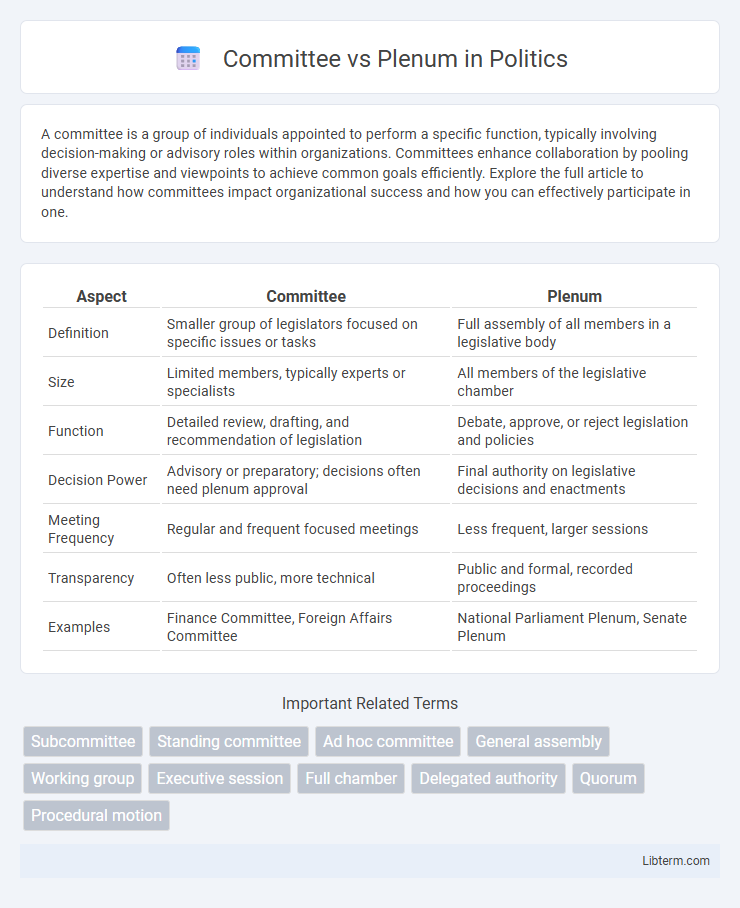A committee is a group of individuals appointed to perform a specific function, typically involving decision-making or advisory roles within organizations. Committees enhance collaboration by pooling diverse expertise and viewpoints to achieve common goals efficiently. Explore the full article to understand how committees impact organizational success and how you can effectively participate in one.
Table of Comparison
| Aspect | Committee | Plenum |
|---|---|---|
| Definition | Smaller group of legislators focused on specific issues or tasks | Full assembly of all members in a legislative body |
| Size | Limited members, typically experts or specialists | All members of the legislative chamber |
| Function | Detailed review, drafting, and recommendation of legislation | Debate, approve, or reject legislation and policies |
| Decision Power | Advisory or preparatory; decisions often need plenum approval | Final authority on legislative decisions and enactments |
| Meeting Frequency | Regular and frequent focused meetings | Less frequent, larger sessions |
| Transparency | Often less public, more technical | Public and formal, recorded proceedings |
| Examples | Finance Committee, Foreign Affairs Committee | National Parliament Plenum, Senate Plenum |
Committee vs Plenum: Key Definitions
A Committee is a smaller, specialized group within a legislative body or organization tasked with detailed examination of specific issues or proposals, facilitating focused discussion and decision-making. In contrast, a Plenum refers to the full assembly of all members of a legislative body or organization, where comprehensive debates and final decisions occur. The Committee's role centers on analysis and recommendation, while the Plenum holds ultimate authority for approval or rejection.
Structural Differences Between Committee and Plenum
A committee is a smaller, specialized group within a larger organization designed to focus on specific tasks or issues, facilitating detailed discussions and decision-making. In contrast, a plenum consists of the full membership of an organization or legislative body, allowing for broad participation and final approval of decisions. Structurally, committees streamline processes through selective membership and concentrated expertise, whereas plenums provide comprehensive representation and collective authority.
Roles and Functions: Committee Versus Plenum
Committees specialize in detailed examination and formulation of policies within specific areas, allowing for expert analysis and focused decision-making on complex issues. Plenums consist of the entire membership, responsible for final deliberation, approval, and adoption of policies or legislation, ensuring broad consensus and democratic legitimacy. The committee's role is to prepare and recommend, whereas the plenum executes authoritative validation and enacts binding decisions.
Decision-Making Processes: Plenum and Committee Compared
Committees streamline decision-making by delegating specialized tasks to smaller groups, enabling in-depth analysis and expert input, which leads to efficient and informed resolutions. Plenums involve all members in decision-making, fostering broad representation and collective validation but often requiring more time to reach consensus. The balance between committees' focused expertise and plenums' comprehensive involvement shapes organizational effectiveness in strategy formulation and policy approval.
Membership Composition: Who Participates?
Committees typically consist of a smaller group of members selected based on expertise, interests, or party representation, enabling focused discussions and specialized tasks. Plenums include the entire membership of a legislative or decision-making body, allowing all participants to engage in debates and vote on issues. The difference in membership composition directly impacts the depth of deliberation and decision-making processes within each forum.
Advantages of Committees Over Plenums
Committees offer specialized expertise, allowing members to focus deeply on specific issues, which enhances thorough analysis and informed decision-making. Their smaller size encourages more efficient discussions and quicker consensus compared to plenums, where larger membership can hinder swift action. Committees also provide greater flexibility in scheduling and topic selection, resulting in more productive and targeted meetings.
Challenges Faced by Plenums vs Committees
Plenums often face challenges due to their large size, which can lead to difficulties in achieving consensus and extended decision-making processes. Committees, being smaller, allow for more focused discussions and quicker resolutions but may lack the broad representation found in plenums. The challenge for plenums is balancing inclusivity with efficiency, while committees must address the risk of narrow perspectives limiting comprehensive outcomes.
When to Use a Committee or a Plenum
A committee is best used when detailed examination, specialized expertise, or focused discussion on specific issues is required, allowing for efficient decision-making and in-depth analysis. A plenum is appropriate when broad representation and inclusive debate are necessary, such as during major policy decisions or organizational voting that requires input from all members. Choosing between a committee and plenum depends on the scope of the topic, the need for specialization versus inclusivity, and the desired speed of decision implementation.
Real-World Examples of Committees and Plenums
Committees such as the U.S. House Ways and Means Committee specialize in taxation and revenue policies, enabling focused legislative work within Congress. Plenums, like the annual CPC National Congress Plenum in China, bring together all committee members and additional delegates to debate and decide on broad policy frameworks and leadership directions. These real-world examples illustrate how committees handle detailed issues while plenums facilitate comprehensive decision-making among larger assemblies.
Impact on Organizational Governance: Committee vs Plenum
Committees offer specialized focus, enabling detailed analysis and expert decision-making which enhances organizational governance by promoting efficiency and accountability. Plenums involve all members, fostering inclusivity and broad consensus that strengthen legitimacy and transparency but may slow decision processes. Balancing committee efficiency with plenum inclusivity is crucial for optimal governance outcomes.
Committee Infographic

 libterm.com
libterm.com